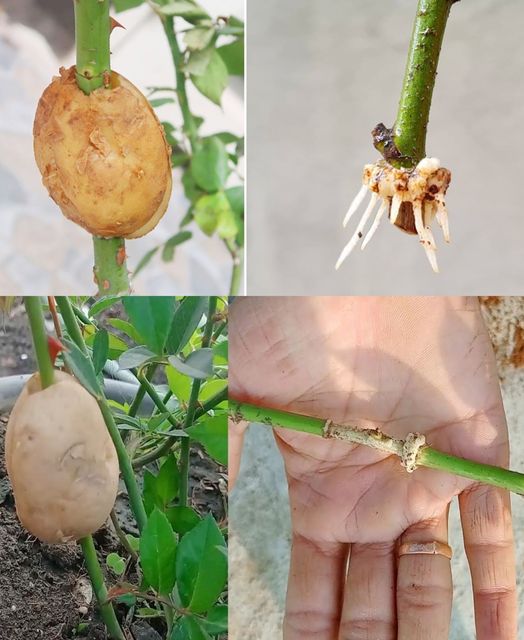While propagating roses with potatoes isn’t a conventional method, it’s an interesting and experimental approach. If you want to try growing roses in potatoes for faster rooting, here’s a guide:
Materials Needed:
- Rose Cuttings: Choose healthy rose cuttings with at least two nodes. These can be cuttings from the rose plant you want to propagate.
- Potatoes: Select fresh and firm potatoes. The potatoes will act as a medium to encourage rooting.
- Sharp Knife or Pruners: For cutting the rose stems and preparing the potatoes.
- Rooting Hormone (Optional): While not necessary, using rooting hormone can potentially enhance the success of the propagation.
- Potting Mix: Prepare a well-draining potting mix suitable for roses.
- Pots or Containers: Containers for planting the potato-wrapped rose cuttings.
- Plastic Wrap or Dome: To create a humid environment for the cuttings.
Procedure:
- Prepare Rose Cuttings:
- Take rose cuttings with at least two nodes. Trim the cuttings just below a node using a sharp knife or pruners.
- Optionally, dip the cut end of each rose cutting into rooting hormone for enhanced root development.
- Prepare Potatoes:
- Cut the potatoes into slices that are approximately 1/2 to 1 inch thick.
- Make a small slit or hole in the center of each potato slice. This slit will hold the rose cutting.
- Insert Rose Cuttings into Potatoes:
- Insert the trimmed end of each rose cutting into the slit or hole in the potato. Ensure a snug fit.
- Prepare Pots:
- Fill pots or containers with the well-draining potting mix.
- Plant the potato-wrapped rose cuttings into the pots, burying them into the soil.
- Cover with Plastic Wrap or Dome:
- Cover the pots with clear plastic wrap or a plastic dome to create a humid environment that encourages rooting.
- Place in Indirect Light:
- Position the pots in a location with indirect sunlight. Protect the cuttings from intense sunlight during the initial stages.
- Keep Soil Moist:
- Water the planted cuttings gently to keep the soil consistently moist but not waterlogged.
- Monitor Growth:
- Monitor the propagated rose cuttings for signs of new growth and root development.
- Once the cuttings have established roots and show healthy growth, you can consider transplanting them to larger pots or directly into the garden.
Note: While this method is experimental, it’s important to keep in mind that success rates can vary. Traditional methods of rose propagation, such as using cuttings in a well-prepared rooting medium, are more established and widely practiced for reliable results. If you find success with growing roses in potatoes, it’s a unique and creative approach to propagation. Happy gardening!
